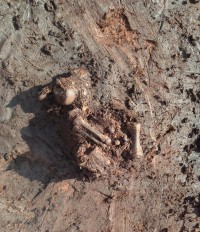 Workers for Ireland’s semi-state peat harvesting company Bord Na Móna discovered an ancient bog body in Rossan Bog last Saturday, September 13th. As per protocol, when the remains were found, work stopped and the gardai (police) were called. When the gardai determined that it was not a contemporary crime scene, they quickly informed the National Museum of Ireland which has the largest collection of bog bodies of any museum in the world.
Workers for Ireland’s semi-state peat harvesting company Bord Na Móna discovered an ancient bog body in Rossan Bog last Saturday, September 13th. As per protocol, when the remains were found, work stopped and the gardai (police) were called. When the gardai determined that it was not a contemporary crime scene, they quickly informed the National Museum of Ireland which has the largest collection of bog bodies of any museum in the world.
Rossen Bog straddles two counties. The partial remains — only the lower leg, foot bones and some flesh were recovered — were found close to the border with County Westmeath, two miles from the town of Kinnegad where another bog body was found in December of 2012. Later named Moydrum Man, the 2012 body was radiocarbon dated to 700 – 300 B.C.
Maeve Sikora of the Irish Antiquities Division, who led the Museum’s fieldwork team said the fact that two bodies were unearthed in such close proximity to each other makes the find even more exciting.
“A lower leg of an individual was discovered. We don’t yet know how old it dates back to or whether it was male or female. We will be carrying out tests over the coming months to determine more information about this body but because it was the lower leg this could prove difficult,” Ms Sikora told the Westmeath Examiner today.
“Because it was found at the site where another bog body was found two years ago it makes it all the more interesting,” she continued. “The 2012 find dates back to at least 700 – 300 BC, so it was prehistoric. That’s why it’s unusual to find two in the one place extremely close together and it makes it all the more exciting because it shows that it was an area where a lot of activity took place.”
National Museum of Ireland archaeologists and conservators excavated the find site over the weekend and the removed the bog body to its conservation laboratory at Collins Barracks, Dublin. Even though little remains of the body, the oxygen-free environment of peat uniquely preserves organic materials that decay rapidly in other contexts. Thus, the bones and tissues that have been recovered may prove a rich source of information about the deceased. Having another body discovered nearby to compare it to will shed rare light on he Bronze Age life and religious practices in the area.